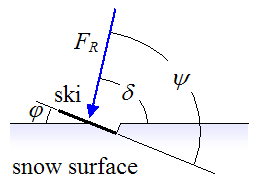One of the instructors on our CSIA L3 prep course back in Feb had this interesting way of challenging our thinking. After listening to replies on some question or assess some-one's skiing he'd ask: "Are you sure?" Generally time to think again.
So it's in that spirit I make this case.
In another thread there was much discussion on this thing called critical angle, defined as the contact angle between the ski base and the surface.0 degrees for a ski sitting flat on the surface and progressively larger angle as we start flashing the ski bases to the scenery. Supposedly there's a critical angle such that a ski carrying weight will slip prior to this critical angle being reached when tipping the skis, the exact angle depending on the surface.
Others drew attention to a different angle - platform angle. This is the angle between the ski base and the force vector of the skier's center of mass due to gravity and turning.
This reference https://www.real-world-physics-problems.com/physics-of-skiing.html (thank you @skier) indicates why the platform angle is key and the angle between the ski base and the snow is not at all critical - see the section Preventing Ski From Slipping On Snow.

As long as the angle ψ is greater than 90 degree then there will be a component of that force vector Fr that will be pressing the ski into the snow and there will be no force to make the ski slip. This will happen even from a ski flat on the snow as long as we angulate our CoM and stay over the ski.
Note for those familiar with the Ron Lemaster diagram of platform angle. The angle Ron uses is the other angle of the ski base force and force vector (180 degrees - ψ). So that angle must be kept less than 90 degrees. Same result.
So it's in that spirit I make this case.
In another thread there was much discussion on this thing called critical angle, defined as the contact angle between the ski base and the surface.0 degrees for a ski sitting flat on the surface and progressively larger angle as we start flashing the ski bases to the scenery. Supposedly there's a critical angle such that a ski carrying weight will slip prior to this critical angle being reached when tipping the skis, the exact angle depending on the surface.
Others drew attention to a different angle - platform angle. This is the angle between the ski base and the force vector of the skier's center of mass due to gravity and turning.
This reference https://www.real-world-physics-problems.com/physics-of-skiing.html (thank you @skier) indicates why the platform angle is key and the angle between the ski base and the snow is not at all critical - see the section Preventing Ski From Slipping On Snow.

As long as the angle ψ is greater than 90 degree then there will be a component of that force vector Fr that will be pressing the ski into the snow and there will be no force to make the ski slip. This will happen even from a ski flat on the snow as long as we angulate our CoM and stay over the ski.
Note for those familiar with the Ron Lemaster diagram of platform angle. The angle Ron uses is the other angle of the ski base force and force vector (180 degrees - ψ). So that angle must be kept less than 90 degrees. Same result.
